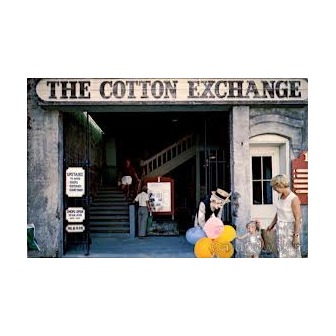Cotton Exchange





At the turn of the century, majestic sailing ships delivered treasures from around the world to the Port of Wilmington. Paddle-wheel boats plied the broad Cape Fear River from Southport to Fayetteville. Cotton was king, and one of the largest and busiest cotton export companies in the world was located in Wilmington. Today, The Cotton Exchange is still an adventure in trade. Eight graciously restored buildings connected by brick walkways, open-air courtyards, and gigantic heart pine beams house 30 unique specialty shops and restaurants, each a charming reflection of the style and feel of Wilmington's 19th century working port days.
In 1975-76, The Cotton Exchange was the first downtown complex in North Carolina to adapt and utilize existing buildings, serving as an excellent example of local preservation efforts.n constant occupancy since the pre-Civil War decade, the Sprunt Building was home of the Cape Fear Flour and Pearl Hominy Mill in 1884--the largest of its kind in the South. In 1919-20, Alexander Sprunt & Sons rebuilt the structure to its current Neoclassic revival style to house the thriving cotton export business. They shipped cotton to ports in Europe, England, and America, and the Sprunt Building overlooked all the cotton compresses on the river and was, in actuality, a cotton exchange.
The Wood Seed Building housed a Chinese laundry in 1917, E.C. Moore's Wholesale Notion Company in the 1930s, and in 1938 T.W. Wood & Son's Seed Company. The Winslow Merrick Barber Shop, a popular barber shop frequented by railroad executives, was also located here. The Granary Building, located on Nutt Street, formerly housed the Boney & Harper Milling Company, which in 1912 was capable of producing 4,000 bushels a day of pearl hominy, grits, and cornmeal, sold under the Diamond B trademark. In 1884, the Dahnhardt Building was a three-story mariner's saloon. In 1900, W.B. Cooper moved his wholesale grocery and peanut cleaning operation here.
he Bear Building was occupied in 1913 by a wholesale grocer. As a result of a fire in 1974, followed by hurricane force winds which leveled the back wall, the building now exists as two stories, with a three-story façade on Front Street. The O'Brien Building housed Sears, Roebuck, and Company around 1930. The brass doors on Front Street are from an Atlanta Bank; the stained glass and top wall railings came from demolished Wilmington homes.
The Front Street Entrance at 313 North Front Street was occupied by the LeGwyn Printing Company in 1910, and later served as the entrance to Sutton-Council Furniture Company. The Nutt Street Entrance was probably used as a storage and loading area for the milling operation. The steps are built from materials salvaged from the burned Bear Building. The Cotton Exchange invites you to visit us on the historic Wilmington riverfront. Special treasures, old-fashioned service, and a sense of history make The Cotton Exchange an exciting shopping adventure.
Explore Related Categories







